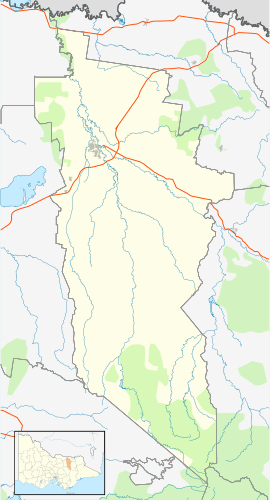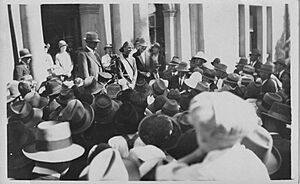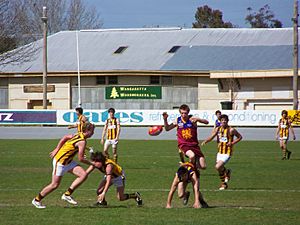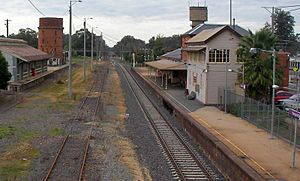Wangaratta facts for kids
Quick facts for kids WangarattaVictoria |
|||||||||
|---|---|---|---|---|---|---|---|---|---|
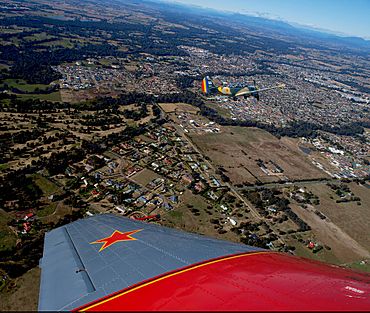
Aerial view from the north-west, Hume Freeway bypass somewhere around top, One and Three Mile creeks meeting around the middle.
|
|||||||||
| Population | 29,808 (2021) | ||||||||
| • Density | 517.5/km2 (1,340/sq mi) | ||||||||
| Elevation | 150 m (492 ft) | ||||||||
| Area | 57.6 km2 (22.2 sq mi)(2011 urban) | ||||||||
| Time zone | AEST (UTC+10) | ||||||||
| • Summer (DST) | AEST (UTC+11) | ||||||||
| Location |
|
||||||||
| LGA(s) | Rural City of Wangaratta | ||||||||
| County | Moira, Delatite, Bogong | ||||||||
| State electorate(s) | Ovens Valley | ||||||||
| Federal Division(s) | Indi | ||||||||
|
|||||||||
Wangaratta (pronounced WANG-gə-RAT-ə) is a city in northeast Victoria, Australia. It is about 236 kilometers (147 miles) from Melbourne along the Hume Highway. In 2021, the city had a population of 29,808 people.
Wangaratta is where the Ovens and King rivers meet. These rivers flow from the Victorian Alps. The city is the main center and largest city in the Rural City of Wangaratta local government area.
Contents
- History of Wangaratta
- People of Wangaratta
- City Layout and Important Buildings
- Wangaratta's Climate
- How Wangaratta is Governed
- Local Industries
- Culture and Sports
- Education in Wangaratta
- Getting Around Wangaratta
- Environmental Concerns
- Media in Wangaratta
- Famous People from Wangaratta
- Images for kids
History of Wangaratta
The first people to live in the Wangaratta area were Aboriginal groups. These included the Pallanganmiddang, WayWurru, and Waveroo peoples.
Early European Exploration
The first European explorers, Hume and Hovell, passed through in 1824. They named the Oxley Plains, just south of Wangaratta. In 1836, Major Thomas Mitchell explored the area. He said it was good for grazing animals.
The first settler, Thomas Rattray, arrived in 1838. He built a hut, starting a small settlement called "Ovens Crossing." The Post Office opened there on February 1, 1843, named Ovens. It was one of the first inland post offices in the Port Phillip District.
Naming the City
Colonial surveyor Thomas Wedge named the area Wangaratta in 1848. The name came from a local cattle station. It is believed to mean "nesting place of cormorants" or "meeting of the waters" in an Indigenous language. Soon after, land was sold, and about 200 people lived there. The first school opened with 17 students.
Gold Rush and Growth
Gold was discovered near Beechworth in February 1852. By the end of that year, over 8,000 gold seekers came to the Ovens and Beechworth goldfields. Wangaratta became an important place to get supplies for these gold miners. Because of this, the first bridge over the Ovens River was finished in early 1855.
On June 19, 1863, the Borough of Wangaratta was officially formed with a seven-member council. The 1870s brought important services like the first water supply. Wangaratta hospital opened in 1871, and a fire brigade started in 1872. The railway line to Melbourne opened on October 28, 1873. By 1884, the railway connected Wangaratta to Sydney.
By 1900, the population reached 2,500. The city center had many hotels, shops, and public buildings.
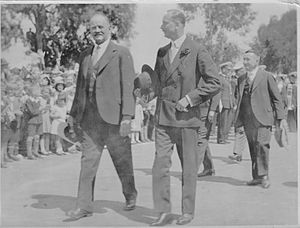
Bruck textile mills started in 1946, providing jobs for over a thousand people. Wangaratta officially became a city on April 12, 1959, with 12,000 residents. New city offices opened in 1980. These became the main offices for the Rural City of Wangaratta after different local councils joined together in 1995.
People of Wangaratta
The 2021 census showed there were 29,808 people in Wangaratta.
- About 1.9% of the people were Aboriginal and Torres Strait Islander.
- Most people (84.6%) were born in Australia. Other countries of birth included England (1.9%), Italy (1.0%), and New Zealand (0.7%).
- Almost 90% (89.0%) of people spoke only English at home. Italian was the next most common language, spoken by 1.4% of people.
- For religion, 41.7% said they had no religion. Catholic was 23.6%, and Anglican was 12.0%.
City Layout and Important Buildings
The city's layout is a bit unusual. The main business area is at the northeast end of the city. The neighborhoods spread out mostly to the south and west. This is because the land north and east of the business area used to flood often. Levees (walls to prevent flooding) were built in the 1990s, but new buildings have been slow to appear there.
Important buildings in Wangaratta include the Holy Trinity Anglican Cathedral. There is also St. Patrick's Catholic Church and the unique art déco courthouse.
Wangaratta's Climate
Wangaratta has a humid subtropical climate. This means it has hot, humid summers and mild to cool winters. Sometimes, sleet (rain mixed with snow) falls, but heavy snow is very rare.
Rain often comes as thunderstorms in summer. In winter, cold weather fronts bring rain. Sometimes, very hot weather, called heatwaves, happens when dry air from Australia's central deserts moves over the area. Temperatures of 40°C (104°F) or higher happen a few times a year. These heatwaves are often followed by cold fronts that cause temperatures to drop a lot. Wangaratta has cool nights and mornings in summer because of cold air from the Southern Ocean.
The city gets about 105 clear days each year. It is much sunnier from December to March but less sunny from May to September.
The average rainfall is 613.6 mm (24.16 inches) per year. Most of this rain falls in winter. The highest temperature ever recorded was 45.8°C (114.4°F) on January 3, 1990, and again on February 7, 2009. The lowest temperature was -7.2°C (19.0°F) on June 14, 2006.
| Climate data for Wangaratta Aero (1987–2022); 153 m AMSL; 36.42° S, 146.31° E | |||||||||||||
|---|---|---|---|---|---|---|---|---|---|---|---|---|---|
| Month | Jan | Feb | Mar | Apr | May | Jun | Jul | Aug | Sep | Oct | Nov | Dec | Year |
| Record high °C (°F) | 45.8 (114.4) |
45.8 (114.4) |
39.4 (102.9) |
33.9 (93.0) |
28.2 (82.8) |
21.7 (71.1) |
20.0 (68.0) |
23.1 (73.6) |
29.3 (84.7) |
35.8 (96.4) |
41.4 (106.5) |
43.1 (109.6) |
45.8 (114.4) |
| Mean daily maximum °C (°F) | 32.1 (89.8) |
30.9 (87.6) |
27.6 (81.7) |
22.6 (72.7) |
17.4 (63.3) |
13.9 (57.0) |
13.0 (55.4) |
14.5 (58.1) |
17.6 (63.7) |
21.5 (70.7) |
25.8 (78.4) |
29.3 (84.7) |
22.2 (71.9) |
| Mean daily minimum °C (°F) | 14.3 (57.7) |
13.7 (56.7) |
10.8 (51.4) |
7.0 (44.6) |
4.3 (39.7) |
2.9 (37.2) |
2.5 (36.5) |
3.0 (37.4) |
4.6 (40.3) |
6.5 (43.7) |
9.5 (49.1) |
11.8 (53.2) |
7.6 (45.6) |
| Record low °C (°F) | 3.5 (38.3) |
3.0 (37.4) |
1.1 (34.0) |
−2.7 (27.1) |
−5.0 (23.0) |
−7.2 (19.0) |
−5.6 (21.9) |
−6.3 (20.7) |
−3.3 (26.1) |
−3.3 (26.1) |
0.1 (32.2) |
0.9 (33.6) |
−7.2 (19.0) |
| Average precipitation mm (inches) | 44.6 (1.76) |
41.2 (1.62) |
40.7 (1.60) |
38.6 (1.52) |
56.0 (2.20) |
64.9 (2.56) |
63.0 (2.48) |
57.8 (2.28) |
54.3 (2.14) |
51.5 (2.03) |
51.6 (2.03) |
44.2 (1.74) |
613.6 (24.16) |
| Average precipitation days (≥ 0.2 mm) | 5.8 | 5.4 | 6.0 | 6.9 | 10.9 | 14.5 | 16.4 | 14.6 | 11.6 | 9.6 | 8.0 | 7.1 | 116.8 |
| Average afternoon relative humidity (%) | 28 | 32 | 33 | 42 | 56 | 67 | 67 | 61 | 55 | 46 | 38 | 30 | 46 |
| Source: Bureau of Meteorology | |||||||||||||
How Wangaratta is Governed
The Wangaratta area is managed by the Rural City of Wangaratta council. This council was formed in 1994 when several smaller local councils joined together. The main council offices are at the Government Centre in central Wangaratta. Seven councillors are elected every four years by postal voting. The mayor is chosen by these councillors for a one-year term.
In September 2013, the state government removed the council. The Victorian Local Government Minister, Jeanette Powell, said this was because the council "failed to provide effective leadership and service for the community." An administrator took over until the 2016 local government elections.
In state politics, Wangaratta is part of the Ovens Valley district. This seat is currently held by the National Party of Australia. Tim McCurdy is the current Member of Parliament for this area.
In federal politics, Wangaratta is in the Division of Indi. This area was considered a safe seat for the Liberal Party of Australia for many years. However, in 2013, the sitting member, Sophie Mirabella, was defeated by an independent candidate, Cathy McGowan. Dr Helen Haines is now the federal Member of Parliament for Indi. She made history as the first independent candidate to take over from another independent in Federal Parliament.
Local Industries
The nearby Milawa and King Valley region is known for its wine and gourmet food. Other important industries in the area include Australian Textile Mills (formerly Bruck Textiles) and Wilson Fabrics. Merriwa Industries and Australian Country Spinners also operate here.
In the past, the international company IBM used to make computers in Wangaratta.
Culture and Sports
Sports in Wangaratta
Australian rules football, cricket, and Netball are the most popular sports.
There are four Australian rules football clubs in Wangaratta. The Wangaratta Football Club and the Wangaratta Rovers Football Club play in the Ovens and Murray Football League. The North Wangaratta Football Club plays in the Ovens and King Football League. The Rovers and Wangaratta clubs are very close to each other. This shows a historical difference in their members, with Rovers being mostly Catholic and Wangaratta mostly Protestant.
Wangaratta hosted several games for the 2005 Australian Football International Cup. Countries from around the world played Australian rules football at the City Oval and Showgrounds. This event set new attendance records for the tournament.
Cricket in Wangaratta is organized by the Wangaratta and District Cricket Association. Clubs include City Colts, Wangaratta-Magpies, and Rovers United Bruck.
Wangaratta City Football Club is a soccer club based at South Wangaratta Reserve. It started in 1951 and plays in the Albury Wodonga Football Association.
Wangaratta Knights play rugby league in NRL Victoria.
Wangaratta has a horse racing club, the Wangaratta Turf Club. They hold about eleven race meetings a year, including the Wangaratta Cup in April.
Golfers can play at the Wangaratta Golf Club on Yarrawonga Road or the Jubilee Golf Club at Wangandary. There is also a nine-hole course at Boorhaman north of Wangaratta.
The North East Windsport Club sails "Land Yachts" called Blokarts at their site near Springhurst, Victoria.
The city is home to the Northeast Bushrangers basketball team. They play in the Big V basketball league at the Wangaratta YMCA.
Events in Wangaratta
The main yearly event is the Wangaratta Festival of Jazz. It brings famous international musicians and thousands of visitors each year since 1990. The Ales on the Ovens Craft Beer Festival is another popular event.
Education in Wangaratta
Wangaratta has three high schools: Galen Catholic College (private), Cathedral College (private), and Wangaratta High School, which has three campuses.
There are seven primary schools: Our Lady's Catholic Primary School, Appin Park Primary School, Wangaratta West Primary School, Yarrunga Primary School, St. Bernard's Primary School, St. Patrick's Primary School, and Wangaratta (Chisholm Street) Primary School.
Wangaratta also has a special school for students with disabilities, called Wangaratta District Specialist School.
The Goulburn Ovens Institute of TAFE has two campuses in Wangaratta. The Docker Street campus offers many courses, from business to music. The Christensens Lane campus is home to the National Centre for Equine Education and offers courses in gardening.
In 2015, the Christensens Lane campus moved to a larger site on Tone Road. In 2016, Charles Sturt University also opened a campus there. The old Christensens Lane campus was then taken down to make way for new houses.
Getting Around Wangaratta
The Hume Freeway (M31) goes around the city to the south and east. The C314 road is now the main road through the city (as Murphy Street and Wangaratta Road). Wangaratta is also where several other major roads meet, like the Great Alpine Road (B500) and roads to Yarrawonga, Whitfield, and Kilfeera. A city bus service runs every half hour on weekdays and Saturday mornings. It covers Wangaratta's West End, the business district, Yarrunga, and Yarrawonga Road.
Trains serve both passengers and freight. Wangaratta railway station is on the North East railway line, which is the main line between Sydney and Melbourne. The Albury V/Line rail service stops there three times a day. The NSW TrainLink XPT service also stops twice a day in both directions.
In the past, Wangaratta was a busy junction for several smaller railway lines. These included lines to Yackandandah, Whitfield, Bright, and Beechworth. All of these lines have since closed. The current railway line through the town was opened in 1962.
The Murray to the Mountains Rail Trail is a path for cycling and walking. It follows the route of the old Bright railway line. The Hume Freeway runs right next to Wangaratta.
Wangaratta also has a small regional airport, Wangaratta Airport.
Environmental Concerns
Land Contamination at Clay Target Club
In 2016, the EPA Victoria received reports about lead shot being used at the North Wangaratta Recreation Reserve. Lead was found near the Wangaratta Clay Target Shooting Club. The local council tested the area and found lead levels were too high. The club closed for six months to remove the contaminated soil. This soil is now stored by the club. A plan is in place to manage the soil safely.
Smell from Sausage Skin Factory
Van Hessen Australia is a company that makes sausage skins. Their factory on Shanley Street in Wangaratta caused smell pollution in 2022. EPA Victoria received over 160 reports about the smell in just two months.
The bad smell came from Van Hessen's private wastewater treatment system. This included activities like removing sludge and problems with the wastewater treatment pond. The company went beyond what its license allowed. EPA gave them several warnings to stop the smell and keep their system stable.
In December 2023, Van Hessen was found guilty in court. They were ordered to give $75,000 to a project that helps the environment in South Wangaratta.
Media in Wangaratta
Radio Stations
FM
- 87.6 MHz Orbit FM – Relays Kiss FM
- 88.0 MHz Vision Radio Network – Christian radio
- 99.3 MHz RSN Racing & Sport – Horse Racing radio
- 101.3 MHz Oak FM – Community radio
- 102.1 MHz Edge FM – North East Broadcasters
AM
- 756 kHz Radio National – ABC
- 1566 kHz 3NE – North East Broadcasters
Some radio stations from nearby cities like Albury–Wodonga and Shepparton can also be heard in the Wangaratta area.
Famous People from Wangaratta
Many notable people have lived in or are from Wangaratta. Here are a few:
- Rebecca Allen (born 1992), an Australian basketball player.
- William Ah Ket, a Chinese Australian lawyer (1876–1936).
- Daniel Andrews, former Premier of Victoria.
- Sir John Bowser, Premier of Victoria (1917–1918).
- Alipate Carlile, an Australian rules footballer.
- Isobelle Carmody, an author, born in Wangaratta.
- Barrie Cassidy, a political journalist, born in Wangaratta.
- Nick Cave, a popular musician.
- Greg Crump, a 5-time Paralympic Wheelchair Tennis Coach.
- Anne Curtis, a Filipina actress, singer, and TV host.
- Sir Edward "Weary" Dunlop, a famous Australian surgeon and soldier (1907–1993).
- Simon Abney-Hastings, The Rt Hon. The 15th Earl of Loudoun (born 1974), an Australian who inherited a British noble title.
- Belinda Hocking, an Olympic backstroke swimmer, born in Wangaratta.
- Steve Johnson, an Australian rules footballer.
- Chris Naish, a former Australian rules footballer.
- Sophie Mirabella, a former Member of Parliament for Indi (2001–2013).
- Nick Morris, a Paralympic Champion in men's wheelchair basketball (Atlanta 1996).
- Sebastian Pasquali, a soccer player.
- Mette-Marit, Crown Princess of Norway.
- Darcy Vescio, an Australian rules footballer.
- Ben Reid, an Australian rules footballer.
- Sam Reid, an Australian rules footballer.
- Quinton Tidswell, an artist who died in Wangaratta in 1991.
- George Turner, a Science Fiction and Miles Franklin award-winning novelist.
- Dean Woods, an Olympic Champion cyclist (Los Angeles 1984), who passed away in 2022.
Images for kids


